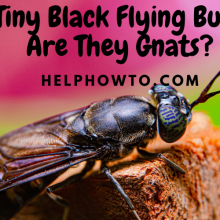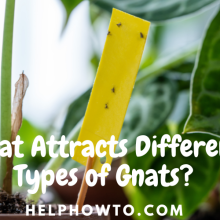Do You Have Fungus Gnats or Soil Gnats? Identification Guide | HelpHowTo
Summary of Answering Do You Have Fungus Gnats or Soil Gnats
Fungus gnats and soil gnats are tiny fly-like pests that can quickly infest and damage indoor houseplants. Proper identification is key as fungus gnats are darker, stronger fliers attracted to light, while soil gnats are plumper with erratic flight near the soil. Fungus gnat larvae feed on fungi and organic matter in top soil layers, whereas soil gnat larvae directly consume plant roots, causing more severe damage.
Signs of infestations include flying adults, soil trails, wilting plants, and yellowing leaves. Using sticky traps, allowing soil to dry out, removing dead matter, applying insecticides or biological controls like Bt are part of an integrated management approach. Preventative measures include using pasteurized soil, quarantining new plants, and monitoring. With their rapid life cycles, these persistent pests require vigilance and targeted treatment tailored to whether fungus gnats or soil gnats are present.

Our Top Recommended Genat Traps
Gnats driving you insane? Bid farewell to these pesky invaders with our ultimate trap showdown! Unveil the top-rated, most effective solutions for eliminating gnats from your home. Check Now

Are Tiny Flies Hovering Around Your Houseplants? Fungus Gnats or Soil Gnats?
For indoor gardeners, few pests are as annoying and stubborn as fungus gnats and soil gnats. These tiny fly-like insects can quickly overrun your beloved houseplants, causing damage and becoming a persistent nuisance. While they may appear similar at first glance, properly identifying whether you have a fungus gnat or soil gnat infestation is crucial for effectively controlling and eliminating them.
Appearance and Flight Patterns
Fungus gnats are small, dark flies around 1/8 inch long with slender bodies, long legs, and antennae. They tend to be stronger fliers that are attracted to light sources. In contrast, soil gnats have a plumper, more rounded body shape and exhibit weak, erratic flight patterns, usually staying close to the soil surface.
The fungus gnat’s stronger flying ability allows it to more easily spread between houseplants and potted plants throughout your home. The soil gnat’s poor flying may limit its spread but makes it harder to locate the source of the infestation.
Life Cycle and Feeding Habits
Understanding the life cycle is key to breaking the persistent cycle of these pests. Fungus gnat females lay their eggs in the top couple inches of moist potting soil, where the larvae or maggots feed on fungi, algae, and organic matter as they develop.
Soil gnat eggs are laid deeper in the soil, with the larvae directly feeding on plant roots and root hairs. This root feeding can cause significant damage to plants, stunting growth and potentially introducing disease pathogens.
Both pests go through a pupal stage before emerging as the pesky adult flies we see flying around our houseplants.
Signs of Infestation and Plant Damage
For fungus gnats, you’ll likely notice the tiny adults flying and hovering around your plants first. Other signs include the presence of larvae or small worm-like trails in the topsoil, wilting plants, and potting media that appears to be overrun.
While fungus gnat larvae can damage roots by feeding, their biggest threat comes from spreading plant pathogens like fungi and bacteria that cause root rot diseases.
Soil gnat infestations often go unnoticed until plants show signs of stress from the larvae’s root feeding. Leaves may yellow, plants appear stunted, or they struggle despite adequate water and nutrients. You may also see “fouling” around the base of plants caused by fungal growth from the larvae’s waste.
Monitoring, Control and Prevention
Using yellow sticky traps or tape positioned over the soil surface can capture adult fungus gnats and soil gnats, helping monitor an infestation’s severity.Inspecting soil samples from the upper few inches for larvae or pupae can identify which pest you’re dealing with before significant plant damage occurs. Quarantining new plants is also recommended.
Since both pests thrive in damp, overly wet conditions, improving drainage, avoiding overwatering, and allowing the soil to dry somewhat between waterings is an important cultural control. Removing dead plant matter also eliminates their food sources.
When infestations are severe, properly timed applications of insecticidal soils drenches, granules, or sprays may be needed as part of an integrated pest management approach. Some products containing entomopathogenic nematodes or fungi like Bacillus thuringiensis can biologically control the larvae.
Systemic insecticides tend to be more effective against soil gnats whose larvae feed directly on the roots, while contact insecticides like pyrethrins work better on fungus gnats. Horticultural oils and soaps, neem oil, and other botanically-derived products can also help control adults and larvae.
Sanitation and Quarantine for Prevention
Of course, preventing infestations in the first place is ideal. In addition to proper watering practices, use a pasteurized potting mix and avoid overly moisture-retentive soil blends. Routinely removing any dead or decaying plant matter is critical.
Carefully inspect all new plant additions, including transplants from outdoor gardens, and quarantine them before introducing them to your indoor plant collection. Periodically monitoring with sticky traps allows for early detection and rapid response to keep these pesky pests from gaining a foothold.
While sharing similar appearances, properly distinguishing between fungus gnats and soil gnats based on their habits and life cycle is essential for developing targeted, effective management strategies for each pest. With vigilance and an integrated approach, you can take back your indoor garden from these persistent houseplant invaders.

Our Top Recommended Genat Traps
Gnats driving you insane? Bid farewell to these pesky invaders with our ultimate trap showdown! Unveil the top-rated, most effective solutions for eliminating gnats from your home. Check Now
FAQs and Answers
How do fungus gnats and soil gnats get into homes in the first place?
Here are some of the common ways that fungus gnats and soil gnats can get into homes:
- Infested potting soil or potting mixes
One of the most common entry points is through containerized plants or new bags of potting soil that already contain fungus gnat or soil gnat eggs or larvae. The pests can hitch a ride indoors this way. - Bringing in infested outdoor plants
If you grow plants outdoors and then bring them inside, any fungus gnats or soil gnats living in that outdoor soil can be introduced to your home environment. - Coming in through open windows/doors
The adult gnats, being small flies, can fly in from the outside through open windows, doors, vents, or cracks and crevices leading indoors. - On fresh produce or flowers
Occasionally, these pests may be present on things like fresh fruits, vegetables or cut flowers brought into the home from outdoors or from a grocery store. - Excess moisture sources indoors
Damp areas like sinks, drains, potted plant trays or spills can attract adult fungus gnats and soil gnats inside, allowing them to lay eggs and start infestations.
Ensuring quarantine of new plants, careful inspection of potting mixes, good sanitation, and removing excess moisture sources can help prevent these pests from gaining entry in the first place. But their tiny size makes it easy for them to sneak in undetected.
How long can fungus gnat and soil gnat infestations persist if left untreated?
Fungus gnat and soil gnat infestations can persist for extremely long periods of time if left untreated, due to their rapid life cycles and reproductive potential.
Fungus Gnats:
- The entire fungus gnat life cycle from egg to adult can occur in as little as 3-4 weeks under warm conditions.
- A single female can lay up to 300 eggs during her lifetime.
- With overlapping generations, numbers can explode quickly into thousands of gnats in just a few months if not controlled.
- Infestations can persist indefinitely as long as moist soil/organic matter conditions that allow larvae to develop remain present.
Soil Gnats:
- The soil gnat life cycle is similarly short, around 3-6 weeks from egg to adult under optimal temperatures.
- Female soil gnats can lay up to 100-300 eggs at a time.
- With abundant root matter to feed on, their populations can surge rapidly.
- Infestations can be ongoing for years if the larvae have a constant supply of plant roots and moist soil environments to thrive in.
For both pests, the key driver allowing persistent, compounding infestations is the short generation time combined with prolific egg-laying by the adult females. As each new generation emerges, the number of flies increases exponentially if not disrupted.
Untreated, fungus gnat and soil gnat populations can remain an ongoing battle for indoor gardeners. Taking an integrated approach to break their life cycles through environmental management, physical removal, and insecticidal controls is necessary to finally eliminate long-standing infestations.
What are the most effective natural or homemade remedies for fungus gnats and soil gnats?
There are several effective natural and homemade remedies that can help control fungus gnats and soil gnats:
- Neem oil
A concentrated neem oil solution can be used as a soil drench or foliar spray. Neem oil smothers and repels the gnats while also disrupting their life cycle. - Bacillus thuringiensis (Bt)
This bacteria-derived biological insecticide specifically targets fungus gnat and soil gnat larvae when applied as a soil soak. It’s very effective yet safe for plants. - Beneficial nematodes
Releasing nematodes like Steinernema feltiae into soil attacks fungus gnat and soil gnat larvae and pupae. The nematodes parasitize and kill them. - Sand barrier
Top-dressing houseplant soil with a 1/4 to 1/2 inch layer of sand prevents adult gnats from laying eggs in the soil. - Hydrogen peroxide
A 3% solution of hydrogen peroxide poured over the soil can kill larvae and pupae through oxidation. - Vinegar trap
Set out small bowls of apple cider vinegar with a drop of dish soap to attract and drown adult gnats. - Cinnamon
Sprinkling cinnamon powder on the soil surface acts as a natural anti-fungal that disrupts the gnat lifecycle. - Sticky traps
Yellow sticky cards placed on the soil catch and monitor the adult populations.
Other homemade options include using soap sprays, allowing soil to dry out between waterings, and physically removing larvae/pupae.
An integrated approach combining multiple remedies tends to be most effective against tough infestations of these persistent pests.
Can fungus gnats or soil gnats bite or spread disease to humans or pets?
No, fungus gnats and soil gnats do not bite or spread disease to humans or pets. They are considered nuisance pests but do not pose direct health risks.
Fungus Gnats:
- The adults are not capable of biting since their mouths are only designed for liquid feeding.
- They do not spread any diseases or pathogens that can infect humans or animals.
- The larvae may carry or vector some plant diseases like pythium root rot, but these do not affect people or pets.
Soil Gnats:
- Like fungus gnats, the adult soil gnats lack any biting or stinging mouthparts.
- They are not known to transmit any infectious diseases or pathogens harmful to humans or pets.
- The soil gnat larvae could potentially introduce plant pathogens into soil, but these microbes are plant-specific.
While large populations can be annoying when the tiny adult gnats get out of potted plants, their only threat is to indoor plants themselves through larval feeding damage and spread of plant diseases.
The gnats pose no risks of:
- Biting or stinging
- Carrying human/pet parasites or pathogens
- Transmitting infectious diseases
- Causing allergic reactions or respiratory issues
In terms of human/pet health, fungus gnats and soil gnats are considered a nuisance pest rather than any kind of health hazard when present indoors. Their effects are limited to potential plant damage.

Our Top Recommended Genat Traps
Gnats driving you insane? Bid farewell to these pesky invaders with our ultimate trap showdown! Unveil the top-rated, most effective solutions for eliminating gnats from your home. Check Now




